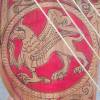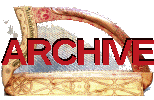We have a repertory of 8 tunes that are said to have been played on the Queen Mary harp in the 18th century.
The Queen Mary harp and the Lamont harp were both kept at Lude House, near Blair Atholl in Perthshire, in the early 18th century and probably for many generations before then as well. They were apparently both kept in playing condition up until the death of John Robertson of Lude in 1730.
There is an anecdote from James Macintosh1 who visited John Robertson at Lude one evening, and was shown the two harps. “The largest one is loudest, but the small one is sweetest. Which do you wish to hear played?” said John, and proceeded to play upon the smaller one (i.e. the Queen Mary harp) “till daylight”.

Gunn p.96-7 (click to enlarge)
In 1807, John Gunn2 published the family traditions about the harps, using information from Robertson family papers and letters now lost. Gunn describes how John Robertson’s music was passed on orally to a fiddle player (Robertson of Strowan), and after a subsequent generation of oral transmission, the repertory was collected, written down and published by the Perth music publisher John Bowie.
John Bowie’s book, A Collection of Strathspey Reels and Country Dances was printed in 1789, and it does indeed contain four pages of harp tunes. They are set with newly composed bass lines, but if you ignore the basses they look convincingly like John Robertson’s repertory as he played it on the Queen Mary harp.

CD: Clàrsach
na Bànrighe
When I was working on my 2008 CD, Clàrsach na Bànrighe, I decided to include this cycle of tunes as performed on the Queen Mary harp by John Robertson in the early 1700s. For the CD I performed them on my then newly commissioned replica of the Queen Mary harp. To perform the one song in the collection, I engaged a Gaelic singer, Mairead Murnion.
The CD booklet includes full details of each of the tunes as well as the song words and translation.
Airs by Fingal
Three tunes in the cycle are titled “Air by Fingal”, which connects them with the ancient sung Fenian lays or Ossianic ballads. It is possible that the first and third are instrumental frames for the second which has a more vocal form. Alasdair Codona has suggested the second may be a version of “Laoidh an Amadain Mor”.



